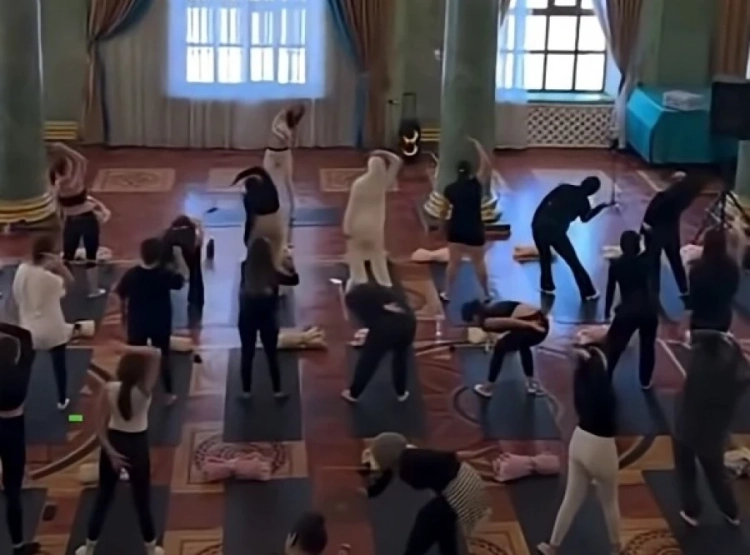Kyrgyz National Academic Theater of Opera and Ballet named after Abdylas Maldybaev
The Kyrgyz National Academic Theater of Opera and Ballet named after Abdylas Maldybaev has gone through a glorious path in its history, becoming the center of the musical culture of the republic.
The beginning of Kyrgyz professional theatrical art is considered to be 1926, when the first musical and dramatic studio was established in Frunze (now Bishkek). Based on this studio, where mainly representatives of amateur art practiced, the Kyrgyz State Theater was founded on November 7, 1930.
During these years, remarkable Russian professional musicians, composers, conductors, artists, directors, and educators came to the republic, having a huge influence on the further development of theatrical art in the republic. Among them were composers: Vladimir Vlasov, Vladimir Fere, Mikhail Raukhverger; conductors: Nathan Rakhlin, Vasily Tselikovsky, Rostislav Mironovich, Valery Rutter; directors: Vladimir Vasilyev, Vladimir Shakhray; artists: Yakov Shtoffer, Anatoly Arefyev; choreographers: Vasily Kozlov, Nikolai Kholfin, Lev Kramarevsky, Leonid Zhukov, and others.
In 1937, the first musical drama "Altyn Kyz" ("Golden Girl") was staged to the music of Vladimir Vlasov and Vladimir Fere, with a libretto by Zhoomart Bokonbaev.
With the release of the performance "Altyn Kyz" in the 1936-1937 season, the dramatic theater transformed into a musical and dramatic theater. In 1938, the second musical drama "Ajal Orduna" ("Not Death, but Life") was released, co-authored by Abdylas Maldybaev, Vladimir Vlasov, and Vladimir Fere, with a libretto by Jusup Turusbekov.
In 1939, the "First Decade of Kyrgyz Art and Literature in Moscow" took place, where the musical dramas "Altyn Kyz," "Ajal Orduna," the opera "Ay-Churek," and a gala concert were presented with great success.
By the decree of the Presidium of the Supreme Soviet of the USSR on June 7, 1939, the theater was awarded the Order of V.I. Lenin for outstanding achievements in the development of theatrical and musical culture and the training of national artistic personnel, and many artists received high awards and all-Union recognition.
On August 17, 1942, the Kyrgyz Musical and Dramatic Theater was reorganized into the Kyrgyz State Theater of Opera and Ballet named after V.I. Lenin.
The staging of Mikhail Raukhverger's ballet "Cholpon" in 1944, with a libretto by Otunchu Sarbagishev and Lev Kramarevsky, became a significant event in the cultural life of the republic. During these years, the bright star of the outstanding ballerina Bibisara Beyshenalieva rose. The film-ballet "Cholpon" featuring Bibisara Beyshenalieva, Uran Sarbagishev, Reyna Chokoeva, and Saparbek Abdujalilov was shown in 40 countries around the world, glorifying the young professional art of Kyrgyzstan.
The construction of the building of the National Academic Theater of Opera and Ballet began in the 1950s along the axis of Dubovoy Park named after Panfilov. Information sources state that the construction was so complex and responsible that a special construction site was created under the leadership of N.P. Provorov. The permanent authorized representative of the architect was Pavel Petrovich Ivanov. P.P. Ivanov was the chief architect of the city of Frunze and is rightly considered the founder of the Kyrgyz architectural school.
In 1955, a new theater building was constructed (auditorium for 941 seats).
After the completion of construction, a majestic building in the style of strict and eternally young classicism emerged, in the best traditions of ancient Greece. This was emphasized by a powerful colonnade supporting a high pediment, which was adorned with monumental sculptures by O.M. Manuilova. They complete the ensemble of this grand building, highlighting its significance as a temple of art. A special decoration of the building was the paintings of G.A. Aitieva, A.N. Mikhalev, L.A. Ilyina, frescoes by F. Stukoshin and K. Koshkin, lamp figures by O. Minkova, and paintings by L. Deimant and L.A. Ignatiev. In the glowing decorations of A.V. Arefyev and A. Moldakhmatov shone the mastery of Byubusara Beyshenalieva, Rina Chokoeva, Sayra Kiyizbaeva, and Bolot Minzhylkiyev.

For achievements in the development of theatrical art, on March 24, 1959, the theater was awarded the honorary title of "Academic."
In 1978, the Kyrgyz State Theater of Opera and Ballet named after V.I. Lenin was named after the composer, People's Artist of the USSR Abdylas Maldybaev.
Abdylas Maldybaevich Maldybaev is a Kyrgyz Soviet composer, opera singer, actor, educator, public figure, and People's Artist of the USSR. The creative legacy of the composer includes about 300 various works, including over 200 songs and choirs. He played a significant role in the creation and development of Kyrgyz Soviet songs, being the founder of new genres for Kyrgyzstan, such as hymn songs, march songs, romances, children's songs, choirs, cantatas, and oratorios.
Leading soloists of the theater have traveled to many countries around the world, representing the opera and ballet art of the republic.
The theater of opera and ballet has given performances and concerts in the most remote corners of Kyrgyzstan, with artists performing in open spaces before livestock breeders in mountain pastures, cotton pickers in the South, beet growers, and grain farmers in the Chui Valley.
The Kyrgyz State Academic Theater of Opera and Ballet named after Abdylas Maldybaev, being a particularly valuable object of the cultural heritage of the peoples of the Kyrgyz Republic, received the status of "National" in accordance with the Decree of the President of the Kyrgyz Republic dated September 14, 2000, No. 259.
More than fifty opera and ballet performances of the recent period have taken place with the participation of world-class stars and leading soloists from foreign countries.
Phone: +996 (312) 66-18-41, 66-14-52, 66-15-53
E-mail: [email protected], [email protected]
Bishkek, Abdrahmanova St., 167



















































